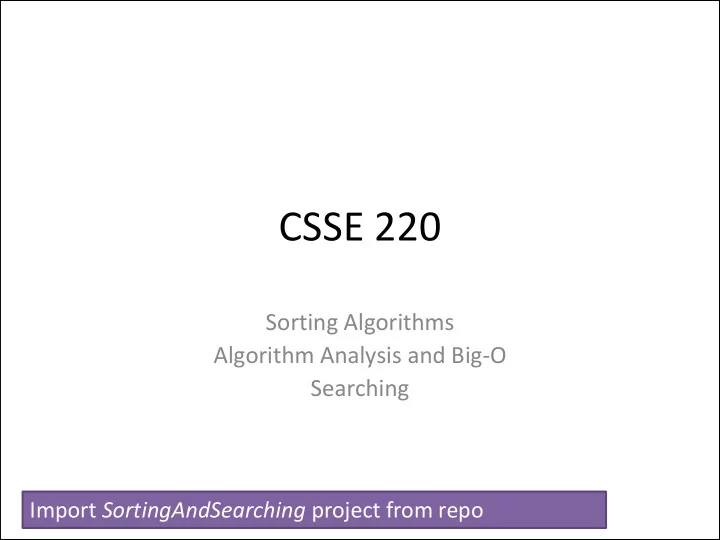

CSSE 220 Sorting Algorithms Algorithm Analysis and Big-O Searching Import SortingAndSearching project from repo
Questions?
Let’s see… WHAT IS SORTING?
WHY STUDY SORTING? • At least 5 well-known algorithms that have the same functionality: 1. Selection sort 2. Insertion sort 3. Merge sort 4. Quick sort 5. Heap sort • Can do an analysis of each algorithm and compare the results • Sorting is done every day all the time – think of the results of a google search
Course Goals for Sorting: You should… • Be able to describe basic sorting algorithms: – Selection sort – O(N 2 ) – Insertion sort – O(N 2 ) – Merge sort – O(N * log 2 (N)) • Know the run-time efficiency of each • Know the best and worst case inputs for each
Course Goals for Sorting: You should… • Sorting Terminology: – Non- decreasing: use ≤ – Non- increasing: use ≥
Selection Sort • Basic idea: – Think of the list array as having a – sorted part (at the beginning) and an unsorted part (the rest) – Find the smallest value in the unsorted part – Move it to the end of the Repeat until sorted part (making the unsorted part is empty sorted part bigger and the unsorted part smaller)
Profiling Selection Sort • Profiling: collecting data on the run-time behavior of an algorithm • In Eclipse, determine how long does selection sort take on: – 10,000 elements? – 20,000 elements? – … – 80,000 elements? Q1
Performance Analysis Basics Come up with a math function f(n) such that it does the following: • input: n = size of the problem to be solved by the algorithm • output: y = f(n) - the number of instructions executed • Only care about Quadrant I
Analyzing Selection Sort • Analyzing: calculating the performance of an algorithm by studying how it works, typically mathematically • Typically we want the relative performance as a function of input size • Example: For an array of length n , how many times does selectionSort() call compareTo() ? • Look at number of times compareTo() is called as a shortcut way to determine the Big-O Q2-Q7
Summation Notation & Facts 𝑜 𝑙 = ? 𝑙=1 Open form 𝑜 𝑙 = 1 + 2 + ⋯ + 𝑜 𝑙=1 𝑜 𝑙 = 𝑜 ∗ 𝑜 + 1 Closed form 2 Induction is used to prove this 𝑙=1
Summation Notation & Facts 𝑜−1 𝑙 = ? 𝑙=0 Open form 𝑜−1 𝑙 = 0 + 1 + 2 + ⋯ + 𝑜 − 1 𝑙=0 𝑜−1 𝑙 = 𝑜 ∗ 𝑜 − 1 Closed form 2 Induction is used to prove this 𝑙=0
Big-Oh Notation • In analysis of algorithms we care about differences between algorithms on very large inputs, i.e., as 𝑜 → ∞ • We say, “selection sort takes on the order of n 2 steps” • Big-Oh gives a formal definition for “on the order of” Q8
Formally • We write f(n) = O(g(n)), and say “f is big - Oh of g” • if there exists positive constants c and n 0 such that • 0 ≤ f(n) ≤ c g(n) for all n > n 0 • g is a ceiling on f
Insertion Sort • Basic idea: – Think of the list array as having a sorted part (at the beginning) and an unsorted part (the rest) – Get the first value in the unsorted part Repeat until unsorted part – Insert it into the correct is empty location in the sorted part, moving larger values up to make room
Insertion Sort Exercise • Profile insertion sort • Analyze insertion sort assuming the inner while loop runs the maximum number of times • What input causes the worst case behavior? The best case? • Does the input affect selection sort? Ask for help if you’re stuck! Q9-Q18
Searching • Consider: – Find China Express’s number in the phone book – Find who has the number 208-2063 • Is one task harder than the other? Why? • For searching unsorted data, what’s the worst case number of comparisons we would have to make? – Brute force approach is required
Binary Search of Sorted Data • A divide and conquer strategy • Basic idea: – Divide the list array in half – Decide whether result should be in upper or lower half – Recursively search that half
Analyzing Binary Search • Analyze Binary search assuming the value searched for is at the start or end of the list array • Question: How many times can you divide a number by 2, and then repeatedly divide the result by 2 until the result ≤ 1? • What’s the best case of Binary Search? • What’s the worst case Binary Search? Q19
Study MergeSort for next class WORK TIME Q20-Q21
Recommend
More recommend